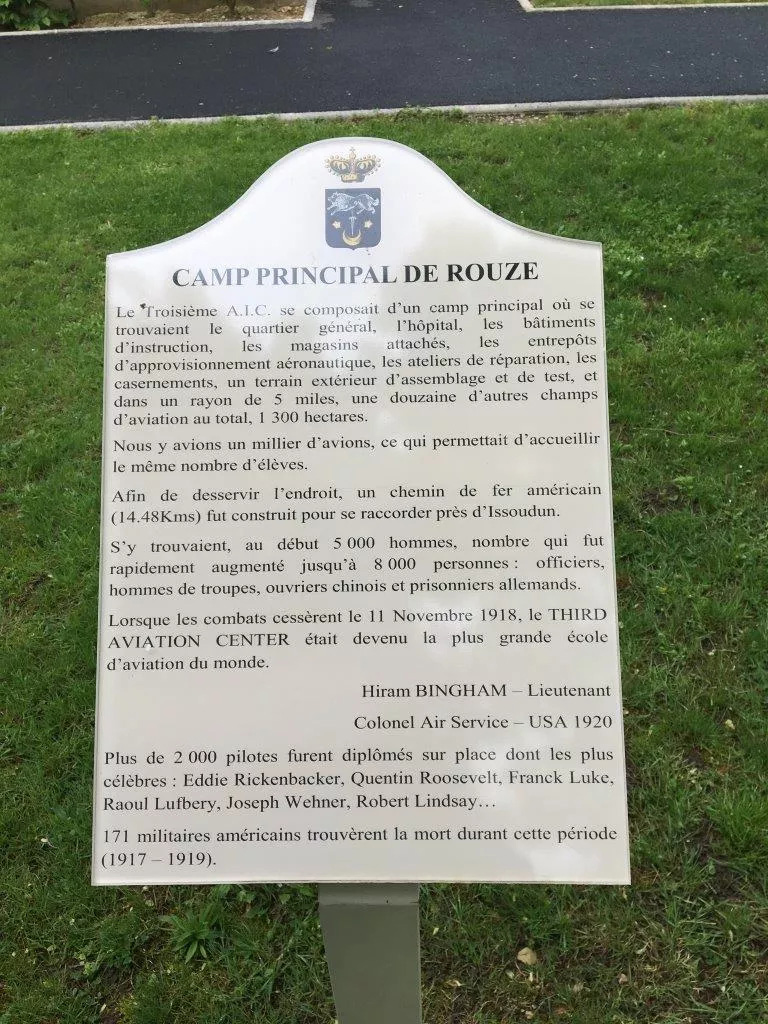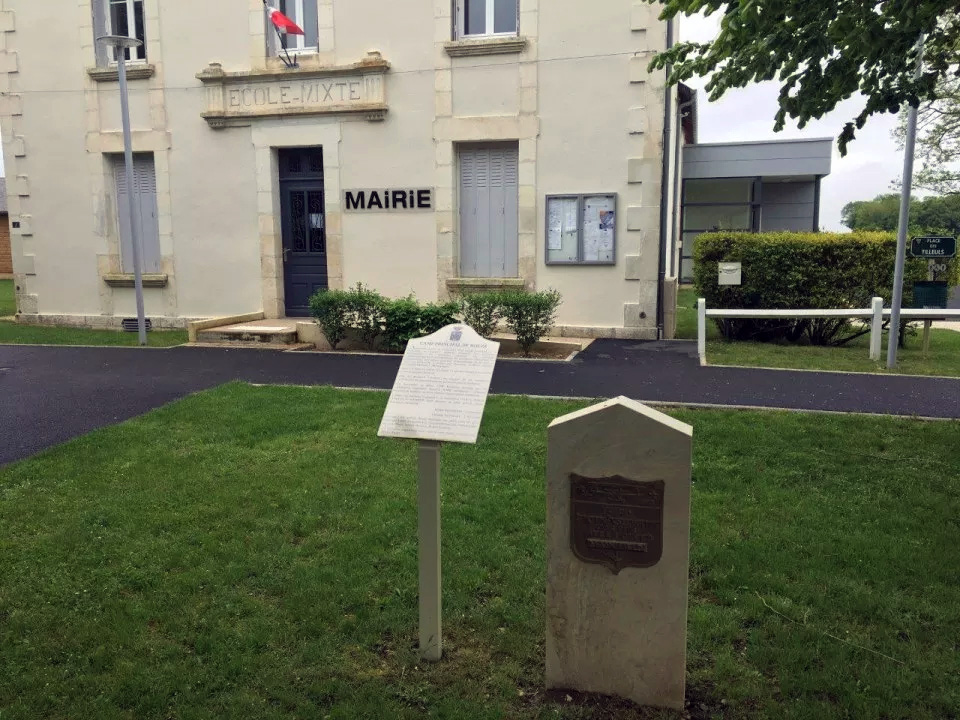Rouze Main Camp Info Sign
Details:
In front of the town hall, beside the Third Aviation Instruction Center AMEX Forces monument.
A rectangular panel with a curved top that contains the history of the Rouze camp which was the main headquarters of the 3rd American Aviation Training Center. The panel is written in French in black and printed lettering. The printed image on the top of the panel is the Lizeray coat-of-arms.
History of the 3rd American Aviation Training Center in Issoudun, 1917-19
On 6 April 1917, exasperated by the torpedoing of their ships, the United States declared war on Germany and joined the Allies in the First World War.
As early as the month of May, there was talk of the creation of an American air force in the Department of Indre, and in the Champagne Berrichonne, there were officers of the American General Staff inspecting the lands likely to be suitable for them.
The arrival of the Americans in 1917
On July 31, about 2,000 "sammies", armed, arrived by the road from Bourges to Issoudun. The history of the 3rd Aviation Training Center of the United States Air Service began.
Seven camps and eleven airfields formed the 3rd Aviation Training Center, which was commanded by Captain Spatz (later General Spaatz) from 15 November 1917 to May 1918, Lieutenant-Colonel Walter G. Kilner for one Month, then again Captain Spatz until August 30, 1918, and Lieutenant Colonel Hiram Bingham (discoverer of Machu Pichu) from August 31 to December 1918.
This center, which was the most important of the nine American aviation centers, was used for the training of pilots and their development in pursuit, shooting, and observation.
All the camps were located in the communes of Lizeray, Saint-Valentin, Ménétréols-sous-Vatan, Paudy and Issoudun:
The camps
N ° 1 the camp of Rouze (650 hectares) Main: Headquarters, aviation, and repair;
N ° 2 the camp of l'Epinière (100 ha.) Aviation;
N ° 3 the camp of the Colombier (100 ha.) Aviation;
N ° 4 the camp of the Nile (100 ha.) Aviation;
No. 5 Camp Cheneviere (150 ha.) Ammunition and the rest of the soldiers coming from the front;
N ° 6 the camp of Chanteloup (100 ha.) Additional. Repair and adjustment of engines;
N ° 7 the camp of Villepruère (100 ha.) Additional. Aviation with two large aircraft.
The Treaty of Versailles, the departure of the Americans.
From January 1919, the Peace Conference was held in Paris, which culminated in the signing, on 28 June 1919, of the Treaty of Versailles, which ended the war with Germany. From then on, it was clear that the American soldiers were going to leave France.
Little by little, all the buildings disappeared that constituted the 3rd United States Aviation Training Center, where the greatest names of American aviation had passed: "Aces of the Ace" Eddie Rickenbacker, General Carl "Tooey" Spaatz, Quentin Roosevelt, Hiram Bingham, Frank Luke, and Raoul Lufbery.
Source of information: www.aerosteles.net, www.worldwar1centennial.org
Source of photos: www.aerosteles.net
Monument Text:
CAMP PRINCIPAL DE ROUZE
Le Troisième A.I.C. se composait d'un camp principal où se trouvaient le quartier général, l'hôpital, les bâtiments, d'instruction, les magasins attachés, les entrepôts d'approvisionnement aéronautique, les ateliers de réparation, les casernements, un terrain extérieur d'assemblage et de test, et dans un rayon de 5 miles, une douzaine d'autres champs d'aviation au total, 1 300 hectares.
Nous y avions un millier d'avions, ce qui permettait d'accueillir le même nombre d'élèves.
Afin de desservir l'endroit, un chemin de fer américain (14.48Kms) fut construit pour se raccorder près d'Issoudun.
S'y trouvaient, au début 5 000 hommes, nombre qui fut rapidement augmenté jusqu'à 8 000 personnes : officiers, hommes de troupes, ouvriers chinois et prisonniers allemands.
Lorsque les combats cessèrent le 11 Novembre 1918, le THIRD AVIATION CENTER était devenu la plus grande école d'aviation du monde.
Hiram BINGHAM — Lieutenant
Colonel Air Service — USA 1920
Plus de 2 000 pilotes furent diplômés sur place dont les plus célèbres : Eddie Rickenbacker, Quentin Roosevelt, Franck Luke, Raoul Lufbery, Joseph Wehner, Robert Lindsay...
171 militaires américains trouvèrent la mort durant cette période (1917 — 1919).
English translation:
Rouze Main Camp
The Third A.I.C. consisted of a main camp with headquarters, hospital, training buildings, attached stores, aeronautical supply warehouses, repair shops, barracks, an outdoor assembly and test field, and within a 5-mile radius, a dozen other airfields totaling 1,300 acres.
We had a thousand airplanes there, which could accommodate the same number of students.
In order to serve the area, an American railroad (14.48Kms) was built to connect near Issoudun.
In the beginning, there were 5,000 men, a number that was quickly increased to 8,000: officers, troops, Chinese workers and German prisoners.
When the fighting stopped on November 11, 1918, the THIRD AVIATION CENTER had become the largest aviation school in the world.
Hiram BINGHAM — Lieutenant
Colonel Air Service — USA 1920
More than 2,000 pilots graduated on the spot, including the most famous: Eddie Rickenbacker, Quentin Roosevelt, Franck Luke, Raoul Lufbery, Joseph Wehner, Robert Lindsay...
171 American soldiers died during this period (1917 - 1919).
Commemorates:
People:
Edward Vernon 'Eddie' Rickenbacker
Units:
3rd Aviation Instruction Center
American Expeditionary Forces (AEF)
United States Air Force
United States Army
US Army Air Service
Wars:
WWI
Other images :


